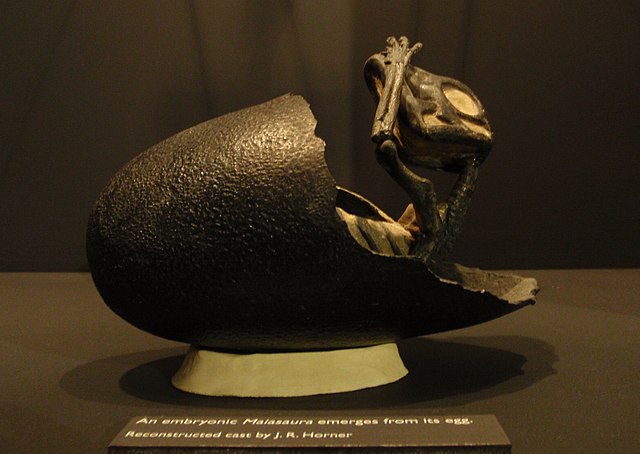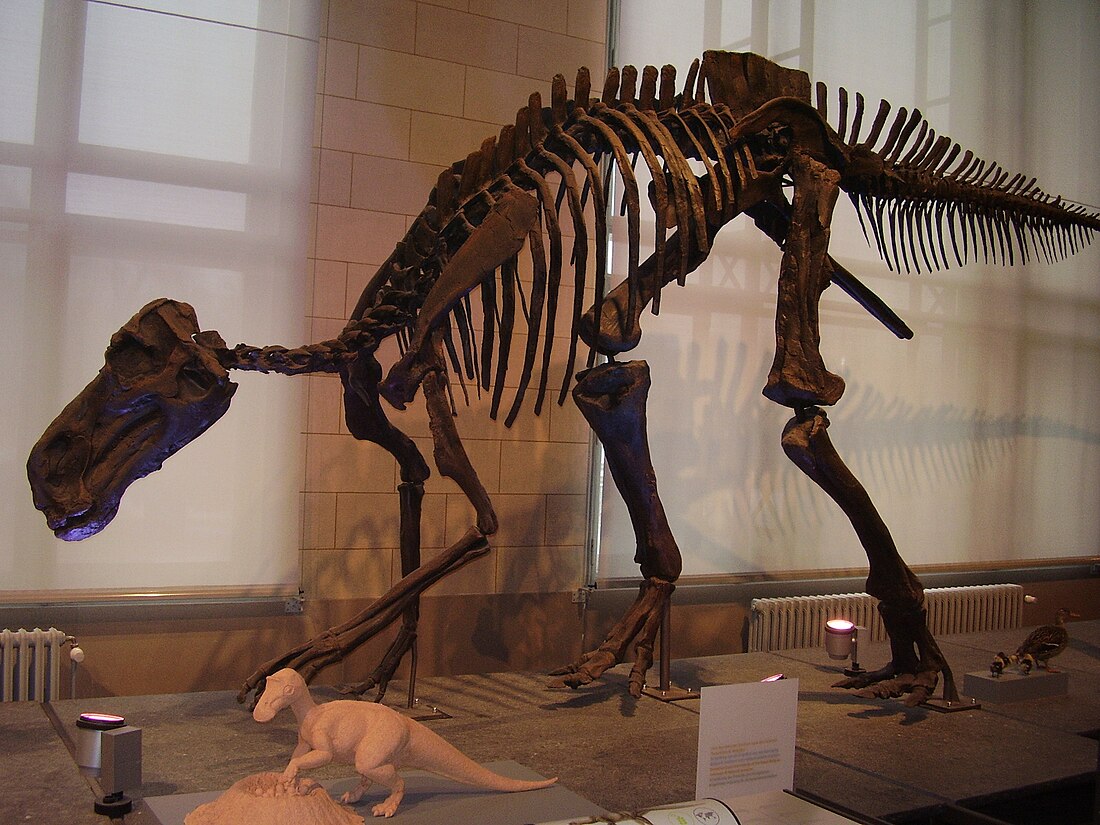慈母龍屬
来自维基百科,自由的百科全书
慈母龍(屬名:Maiasaura,由古希臘語的μαία加上拉丁語saurus的陰性拼法,意為「好媽媽蜥蜴」)是種大型鴨嘴龍科恐龍,生存於晚白堊世坎潘期(約7670萬年前)的拉臘米迪亞。[1]
| 慈母龙属 化石时期:晚白堊世
| |
|---|---|

| |
| 慈母龍骨架模型,展示於布魯塞爾自然史博物館 | |
| 科学分类 | |
| 界: | 动物界 Animalia |
| 门: | 脊索动物门 Chordata |
| 纲: | 蜥形纲 Sauropsida |
| 总目: | 恐龍總目 Dinosauria |
| 目: | †鸟臀目 Ornithischia |
| 亚目: | †鸟脚亚目 Ornithopoda |
| 科: | †鴨嘴龍科 Hadrosauridae |
| 亚科: | †栉龙亚科 Saurolophinae |
| 族: | †短冠龙族 Brachylophosaurini |
| 属: | †慈母龙属 Maiasaura Horner & Makela,1979 |
| 模式種 | |
| †皮氏慈母龍 Maiasaura peeblesorum Horner & Makela,1979
| |
首批化石於1978年在美國蒙大拿州的雙屋層發現,包括頭骨、巢穴、蛋、胚胎以及幼體,是首次得知有明確親代養育證據的恐龍,成為其命名由來,並以此著稱。[2]目前已發現上百具慈母龍的骨骼標本。[3]
慈母龍體型中等,身長約9公尺;具有典型鴨嘴龍科的平坦喙狀嘴以及深厚的鼻部;眼睛前方有小型尖狀脊,可能用於繁殖季節,雄性之間的撞頭比賽。[4]近期的分類研究顯示慈母龍在櫛龍亞科中,可能與短冠龍最近緣,牠們一同構成短冠龍族演化支。[5]
發現
1978年,業餘古生物學家Marion Brandvold與兒子David Trexler及媳婦Laurie在蒙大拿州提頓郡肖托附近的柳溪(Willow Creek)搜尋化石。期間Marion先發現了某種恐龍幼體的骨骼,次年Laurie在同地點發現了大型頭骨。[4]
因為當初發現充滿蛋殼及孵化幼體的巢穴,甚至使該遺址後來被稱作「蛋山」(Egg Mountain),也是第一次發現大型恐龍會照顧後代的證據。[4]1979年,古生物學家杰克·R·霍纳與羅伯·馬凱拉(Robert Makela)命名、敘述了新屬新種皮氏慈母龍(Maiasaura peeblesorum)。屬名象徵著養育親子的形象,以希臘神話中的女神邁亞代表「好母親」之意,並加上拉丁語saurus(蜥蜴)的陰性拼法saura作強調。種名紀念發現地的地主皮博斯家族(John and James Peebles)。[2]
正模標本PU 22405是個帶有部分下頜的頭骨。至少有十五個個體(包括幼體)的部分骨骼被歸入YPM 22400標本。
大量慈母龍的發現引起了學界對雙屋層的重新關注,隨後發現了更多種類的恐龍化石。[6]提頓郡的慈母龍化石出土於比雙屋層更年輕的地層,延伸其生存年代。[7]近年在加拿大老人層也發現了慈母龍化石,進一步拓展了分布範圍。[8]


描述
慈母龍是二足兼四足行走的大型植食性恐龍,已知最大體長可達9公尺。具有典型鴨嘴龍科的平坦喙狀嘴以及深厚的鼻部;眼睛前方有小型尖狀脊,可能用於繁殖季節,雄性之間的撞頭比賽。[4]對骨骼壓力承受的研究顯示,四歲以下的幼體主要以雙足行走,長大後轉變為主要以四足行走。[9]
分類
慈母龍屬於鴨嘴龍科的櫛龍亞科,其中又與短冠龍關係最親近,牠們一同構成短冠龍族演化支。以下演化樹取自皮耶妥·馬奎茲(Alberto Prieto-Márquez)2013年的系統發生學研究:[5]
| 櫛龍亞科 Saurolophinae |
| ||||||||||||||||||||||||||||||||||||||||||||||||||||||||||||||||||||||||||||||||||||||||||||||||||||||||||||||||||
古生物學

慈母龍是群居動物,並且在巢穴集中地孵化幼體。慈母龍的巢穴緊密排列,如同現代海鳥,巢穴之間的間隔約7公尺,短於成年慈母龍的身長[11]。這些巢穴以土壤構成,中間包含30到40顆蛋,以圓形或螺旋狀排列。這些蛋的大小接近鴕鳥蛋的大小[4]。慈母龍的父母將腐爛中的植被置入巢穴中,利用腐爛產生的溫度來孵化蛋,而非父母坐在巢穴中。慈母龍的幼體化石顯示幼體並非發展完全,而且不能行走。化石同時顯示慈母龍幼體的牙齒部份摩損,這意味者牠們的成年體將植物帶回巢穴中給幼體食用[4]。

這些成長中的幼體,在第一年裡的體型從16吋到58吋長。這些幼體可能在一年後離開巢穴。這些成長中的幼體的頭部比例跟成年體的比例不同,幼體有較大的眼睛與較短的口鼻部。[4]
2007年的研究指出慈母龍的食物包括單子葉植物、木本植物、腐木、樹皮、樹葉、蕨類、樹枝、被子植物,代表牠同時扮演覽植者與刮植者的生態棲位。[12][13]
古生態學

慈母龍是雙屋層中部層位(第四層帶)的指標性化石,年代約為7670萬年前。[1]在該層帶慈母龍與傷齒龍科的傷齒龍、小型鳥腳類奔山龍、奔龍科的斑比盜龍、暴龍科的懼龍共存。[1]另一種鴨嘴龍科亞冠龍在雙屋層出土的層位比先前認為得還要低,顯示牠們至少也與慈母龍共存過一段時間。在慈母龍出土範圍內還發現另一種鴨嘴龍科寬齒鉤鼻龍,代表雙屋層中上部動物相之間的分界並不再像以前認為得那麼明確。自從慈母龍於雙屋層出現之後,當地鳥臀目物種似乎產生了大幅多樣化的現象。這份對雙屋層上半部暴露地層的分布情形進行的詳細檢驗,發現多樣化事件確實存在,而非化石保存上的偏差結果。[16]雖然過去的記載經常將慈母龍與雙屋層的角龍科野牛龍相提並論,[17][18]但實際上兩者出土的層位有所差距,慈母龍的年代相對古老許多。[19]
大眾文化
關連項目
- 鴨嘴龍類研究歷史
參考來源
延伸阅读
Wikiwand - on
Seamless Wikipedia browsing. On steroids.
